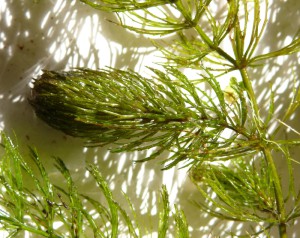 Hornworts can grow at depths down to 9 meters. The plant has a long stem, branching in the upper part. The dark green, coarse and gristly leaves come in whorls along the stem. They are thinly dissected to threadlike segments, often serrate. Hornworts have barely visible small flowers of no petals. Both staminate and pistillate flowers occur on the same plant.
Hornworts can grow at depths down to 9 meters. The plant has a long stem, branching in the upper part. The dark green, coarse and gristly leaves come in whorls along the stem. They are thinly dissected to threadlike segments, often serrate. Hornworts have barely visible small flowers of no petals. Both staminate and pistillate flowers occur on the same plant.
They spend their entire life in water, even during pollination. Ripening, stamens part from the flower and surface. This is where anthers spill the pollen. Being heavier than water, it sinks towards the styles. Water pollination is a rare phenomenon in the vegetative world. But it does run smoothly – it is not fortuitous that the hornwort is so widespread in our waters. Sometimes it even drives all of its cohabitants out. It may be hard rowing in hornwort-grown waters.
Hornworts do not have roots. Their role is carried out by the peculiar pale, almost colorless branches at the base of the stem – they anchor the plant to the mud. Nutrients and minerals are consumed by the entire surface of the plant – both stem and leaves, instead of roots like in other plants.
This wondrous plant does not like one thing – bright sunlight. It tries to escape into the depths or in the shadow of littoral trees.
/ * The photos at lake.peipsi.org are cross-posted from commons.wikimedia.org and are used for familiarization purposes only. No commercial use of the photos is allowed. For more information about to use the photos see the originals on commons.wikimedia.org. /


